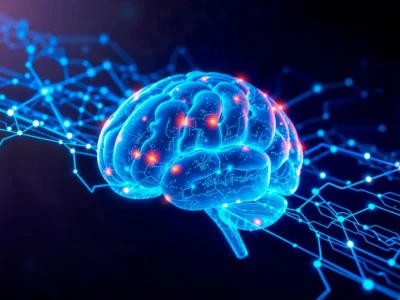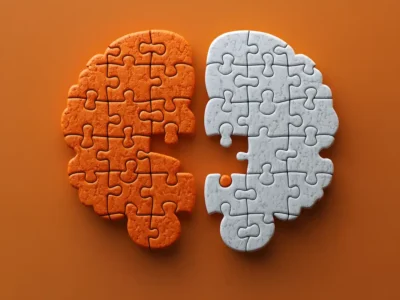Neuropsychologist Conchi Moreno Rodríguez explains in this article how hippocampal atrophy allows differentiation between mild cognitive impairment (MCI) and Alzheimer’s disease (AD), facilitating an early diagnosis and a more precise neuropsychological intervention.
The hippocampus is one of the most researched structures in the field of neuroscience due to its crucial role in memory, among other functions. Although there are differences in diagnostic criteria between mild cognitive impairment (MCI) and Alzheimer’s disease (AD), the hippocampus has been the subject of numerous studies, since its deterioration can be a key indicator to predict the risk that a person will develop dementia in the near future.
What is mild cognitive impairment (MCI)?
During normal aging, it is common for cognitive functions to decline compared to the younger population, such as a reduction in reaction speed. Despite this, older adults remain fully functional in their daily activities.
Mild cognitive impairment (MCI) is characterized by a decline in one of the cognitive functions (for example, memory) compared to their chronological age group (Pose and Manes, 2010; Ríos et al., 2001). To assess this decline, a thorough neuropsychological evaluation is conducted, accompanied by other complementary tests that objectively support the diagnosis. Although their cognitive abilities may be affected, it is not severe enough to impair the individual’s independence (Rosselli and Ardila, 2012).
There are several types of MCI:
- Amnestic MCI, in which memory is exclusively affected;
- Amnestic multidomain MCI in which, in addition to memory being affected, there are also deficits in other functions;
- Non-amnestic MCI, in which other cognitive functions that are not memory processes are altered.
Specifically, people with amnestic MCI are more likely to develop AD in the near future. In amnestic MCI, complaints often include forgetting where they placed a particular object, when or at what time a certain medical appointment was, occasionally losing the thread of a conversation, or frequently relying on tools such as planners, calendars, or alarms to help them remember important information, among others.
It is essential to carry out continuous monitoring both neurologically and neuropsychologically. This monitoring allows evaluation of symptom progression, identification of possible changes in cognitive functioning, and more precise adjustment of necessary therapeutic interventions, since MCI could be a precursor to Alzheimer’s disease (AD).

Subscribe
to our
Newsletter
When do we start to talk about Alzheimer’s?
Alzheimer’s disease (AD) is diagnosed when, after a detailed clinical evaluation that includes neuropsychological tests, neuroimaging studies and biomedical analyses, a significant cognitive impairment is confirmed (especially in memory, although not exclusively). All of this progressively affects the person’s autonomy, generating increasing dependence in their daily activities and, therefore, requires greater supervision by the family.
Mild cognitive impairment (MCI) versus Alzheimer’s disease (AD)
The hippocampus in MCI versus AD
The hippocampus is one of the most studied structures in the field of neuroscience given that the degree of atrophy it presents can be a key indicator to predict whether a person with MCI may progress to AD (López and Calero, 2009; Samper, Llibre, Sánchez and Sosa, 2011).
The relevance of the hippocampus lies in its involvement in memory and learning processes. However, its role is also crucial in other functions such as the control of emotional responses. In addition, it is related to the consolidation of sleep and memory. Furthermore, it also influences the regulation of motivation (Almaguer-Melián and Bergado-Rosado, 2002; Antepara, Jiménez and Junco, 2023; Torres et al., 2015).
The hippocampus is divided into several subfields (Allen and Fortin, 2013; Altamirano, 2022; Mugnaini and Kropff, 2023; Nishijima, Kawakami and Kita, 2013):
- CA1, whose main function is to consolidate long-term memory;
- CA2 related to the formation of memories and emotional responses;
- CA3 which is associated with information retrieval;
- dentate gyrus, which plays a relevant role in the formation of new memories;
- subiculum, related to spatial memory and the encoding of memories.
Among the different types of MCI explained above, some authors (Emmert et al. 2022) indicate that the people with amnestic MCI show a significantly smaller hippocampal volume compared to individuals who have non-amnestic MCI, which suggests that people in the first group may have a greater likelihood of developing AD in the future.
Miao, Zhou, Wu, Chen and Tian (2022) point out that people with MCI tend to have bilateral reduction of hippocampal volume and atrophy on the right side of it, compared to people who do not have any type of cognitive impairment.
When comparing individuals with mild cognitive impairment with those diagnosed with Alzheimer’s, they found that the latter had a more significant reduction in hippocampal volume as well as greater atrophy.
In general, although hippocampal atrophy is observed in both mild cognitive impairment (MCI) and Alzheimer’s disease (AD), the authors observed that in cases of AD such atrophy is more significant. Likewise, they showed that gray matter atrophy in regions beyond the hippocampus, such as the insula, the inferior frontal gyrus, the superior temporal gyrus and the cerebellum, play a crucial role in the conversion from MCI to AD (Miao et al. 2022).
For further exploration of hippocampal atrophy, some authors (Jahanshahi, Naghdi and Khezerloo, 2023) indicate that the asymmetry of hippocampal subfields can be used as a biomarker between Alzheimer’s disease and mild cognitive impairment, since they observed that the asymmetry of some subfields in AD is significantly different from that of individuals with MCI.
In the same line, (Zilioli et al. 2024) conducted a study on possible changes in the hippocampal subfield, discovering that atrophy in the subiculum, presubiculum and the dentate gyrus was evident in MCI, but worsens significantly when the person begins a dementing process toward AD. Cao et al. (2024) indicate that among the different hippocampal subfields, the subiculum could be of greatest clinical relevance for assessing disease progression.
A recent study points out that, even in the preclinical phase of Alzheimer’s disease, the deposition of tau proteins in temporal regions could contribute to changes in the hippocampus and that, furthermore, the right hippocampus shows greater vulnerability to such changes than the left (Pan et al. 2025).
Cognitive stimulation in MCI versus AD
Cognitive stimulation is one of the most employed treatments to prevent and/or slow the process of cognitive decline. A meta-analysis concluded that cognitive stimulation improves the functioning of various cognitive abilities such as orientation, attention, praxis and, among others, memory (Gómez-Soria et al. 2023).
However, due to the differences that exist between mild cognitive impairment and Alzheimer’s disease (AD), the results obtained from cognitive stimulation also differ depending on the type of diagnosis, since cognitive functions in the latter group are significantly worse. Even within the stage in which the individual with an AD diagnosis may be found, different results can be obtained, for example, the study by González, Satorrres, Soria and Meléndez (2022) who observed that the cognitive stimulation in people with AD improves mnemonic capacity, but its effects decrease after three months of follow-up.
Commonly, the work of cognitive stimulation through online neurorehabilitation programs is well known. However, it has recently been observed that virtual reality can help improve cognitive functions such as memory in patients with MCI (García, 2023) and AD, although taking into account that such activities generalize to the individual’s daily life (Cisne and Fabricio, 2022).
In addition to cognitive stimulation, other studies have focused on the effects of physical exercise on hippocampal connectivity, demonstrating that people with MCI, after a physical training program, experience an increase in hippocampal connectivity and, therefore, better performance in their mnemonic capacity (Won et al., 2021).
Conclusions
Systematic follow-up facilitates the implementation of personalized strategies that may include cognitive stimulation, pharmacological interventions and lifestyle modifications, with the aim of optimizing the person’s quality of life and, in some cases, slowing the progression of decline. In addition, it provides valuable information for family members and caregivers, allowing them to adapt their support to the changing needs of the patient.
On the other hand, the importance of people, both those diagnosed with MCI and those suffering from AD, complementing cognitive stimulation with physical training is increasingly relevant, since these two factors favor an increase in the likelihood that the person’s cognitive functioning will improve.
Bibliography
- Allen, T. A. and Fortin, N. J. (2013). Evolution of episodic memory. Ludus Vitalis, 21(40), 125-150.
- Almaguer-Melián, W. and Bergado-Rosado, J. A. (2002). InterActions between the hippocampus and the amygdala in synaptic plasticity processes. A key to understanding the relationships between motivation and memory. Rev Neurol, 35(6), 586-93.
- Altamirano Reséndiz, A. L. (2022). Effect of prolame on recognition memory and the neuronal morphology of the hippocampus of aged mice.
- Antepara, F. A. A., Jiménez, F. C. B. and Junco, N. S. C. (2023). Cognitive functions and the role of the hippocampus in memory. E-IDEA 4.0 Revista Multidisciplinar, 5(15), 52-64.
- Cao, J., Tang, Y., Chen, S., Yu, S., Wan, K., Yin, W., … and Sun, Z. (2024). The Hippocampal Subfield Volume Reduction and Plasma Biomarker Changes in Mild Cognitive Impairment and Alzheimer’s Disease. Journal of Alzheimer’s Disease, 98(3), 907-923.
- Cisne, I. R. S., and Fabricio, S. G. A. (2023). Effectiveness of the Use of Virtual Reality in Memory Rehabilitation Processes in Patients with a Diagnosis of Mild Cognitive Impairment or Alzheimer’s Disease (Master’s thesis, Quito: Universidad de las Américas, 2023).
- Emmert, N. A., Reiter, K. E., Butts, A., Janecek, J. K., Agarwal, M., Franczak, M., Reuss, J., Klein, A., Wang, Y., and Umfleet, L. G. (2022). Hippocampal Volumes in Amnestic and Non-Amnestic Mild Cognitive Impairment Types Using Two Common Methods of MCI Classification. Journal of the International Neuropsychological Society: JINS, 28(4), 391–400. https://doi.org/10.1017/S1355617721000564
- García Guerrero, C. E. (2023). Use of technology in the cognitive rehabilitation of mild cognitive impairment.
- Gómez-Soria, I., Iguacel, I., Aguilar-Latorre, A., Peralta-Marrupe, P., Latorre, E., Zaldívar, J. N. C., and Calatayud, E. (2023). Cognitive stimulation and cognitive results in older adults: A systematic review and meta-analysis. Archives of gerontology and geriatrics, 104, 104807.
- González-Moreno, J., Satorres, E., Soria-Urios, G., & Meléndez, JC (2022). Cognitive stimulation in moderate Alzheimer’s disease. Revista de Gerontología Aplicada , 41 (8), 1934-1941
- Jahanshahi, A. R., Naghdi Sadeh, R., and Khezerloo, D. (2023). Atrophy asymmetry in hippocampal subfields in patients with Alzheimer’s disease and mild cognitive impairment. Experimental Brain Research, 241(2), 495-504.
- Miao, D., Zhou, X., Wu, X., Chen, C., and Tian, L. (2022). Hippocampal morphological atrophy and distinct patterns of structural covariance network in Alzheimer’s disease and mild cognitive impairment. Frontiers in Psychology, 13, 980954
- López, Á. G. and Calero, M. D. (2009). Predictors of cognitive decline in the elderly. Revista española de geriatría y gerontología, 44(4), 220-224.
- Mugnaini, M. and Kropff, E. (2023). Influence of new neurons of the dentate gyrus on the formation of spatial memories in the mouse hippocampus (Doctoral dissertation, Laboratory of Physiology and Brain Algorithms, Laboratory of Neuronal Plasticity, Funcionamiento Instituto Leloir Buenos Aires).
- Nishijima, T., Kawakami, M. and Kita, I. (2013). Long-term exercise is a potent trigger for the induction of BFosB in the hippocampus along the dorso-ventral axis doi: 10.1371 / journal.pone.0081245.
- Pan, N., Liu, S., Ge, X., Zheng, Y., and Alzheimer’s Disease Neuroimaging Initiative. (2025). Association of hippocampal atrophy with tau pathology of temporal
- regions in preclinical Alzheimer’s disease. Journal of Alzheimer’s Disease, 13872877251314785.
- Pose, M. and Manes, F. (2010). Mild cognitive impairment. Acta Neurológica Colombiana, 26(3 Supl 1), 7-12.
- Ríos, C., Pascual, L. F., Santos, L., López, E., Fernández, T., Navas, I., … and Morales, F. (2001). Working memory and complex activities of daily living in the initial stage of Alzheimer’s disease. Revista de Neurología, 33(8), 719-722.
- Rosselli, M. and Ardila, A. (2012). Mild cognitive impairment: definition and classification. Revista Neuropsicología, Neuropsiquiatría y Neurociencias, 12(1), 151-162.
- Samper, J. A., Llibre, J. J., Sánchez, C. and Sosa, S. (2011). Mild cognitive impairment. A step before Alzheimer’s disease. Revista Habanera de Ciencias Médicas, 10(1), 27-36.
- Torres, J. S. S., Córdoba, W. J. D., Cerón, L. F. Z., Amézquita, C. A. N. and Bastidas, T. O. Z. (2015). Functional correlation of the limbic system with emotion, learning and memory. Morfolia, 7(2), 29.
- Won, J., Callow, D. D., Pena, G. S., Jordan, L. S., Arnold-Nedimala, N. A., Nielson, K. A., and Smith, J. C. (2021). Hippocampal functional connectivity and memory performance after exercise intervention in older adults with mild cognitive impairment. Journal of Alzheimer’s Disease, 82(3), 1015-1031.
- Zilioli, A., Pancaldi, B., Baumeister, H., Busi, G., Misirocchi, F., Mutti, C., … and Spallazzi, M. (2024). Unveiling changes in the hippocampal subfield along the continuum of Alzheimer’s disease: A systematic review of neuroimaging studies. Brain Imaging and Behavior, 1-15.
If you liked this article about the hippocampal atrophy in mild cognitive impairment (MCI) and Alzheimer’s, you’re likely to be interested in these NeuronUP articles:
“This article has been translated. Link to the original article in Spanish:”
Atrofia hipocampal: Diferencias entre deterioro cognitivo leve (DCL) y alzhéimer







 NeuronUP study that predicts cognitive decline receives prestigious international recognition
NeuronUP study that predicts cognitive decline receives prestigious international recognition
Leave a Reply